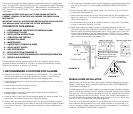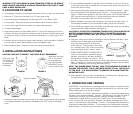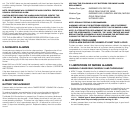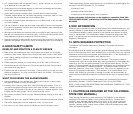
USE ONLY THE FOLLOWING 9 VOLT BATTERIES FOR SMOKE ALARM
REPLACEMENT.
Carbon Zinc Type: EVEREADY 216 OR 1222;
GOLD PEAK 1604P OR 1604S
Alkaline Type: EVEREADY 522; DURACELL MN1604, MX1604
GOLD PEAK 1604A
Lithium Type: ULTRALIFE U9VL
NOTE: REGULAR TESTING IS RECOMMENDED.
WARNING!! USE ONLY THE BATTERIES SPECIFIED. USE OF DIFFERENT
BATTERIES MAY HAVE A DETRIMENTAL EFFECT ON THE SMOKE ALARM.
NOTE: IF AFTER BATTERY REPLACEMENT THE UNIT CONTINUES TO CHIRP,
WAIT FOR APPROXIMATELY 7 MINUTES. THE “HUSH” FEATURE MAY HAVE
BEEN ACTIVATED ACCIDENTALLY WHILE CHANGING THE BATTERIES AND
PUSHING THE TEST BUTTON WILL END THE HUSH CYCLE.
CLEANING YOUR ALARM
YOUR ALARM SHOULD BE CLEANED AT LEAST ONCE A YEAR
To clean your alarm, remove it from the mounting bracket as outlined in the beginning
of this section. You can clean the interior of your alarm (sensing chamber) by using
compressed air or a vacuum cleaner hose and blowing or vacuuming through the
openings around the perimeter of the alarm. The outside of the alarm can be wiped
with a damp cloth.
After cleaning, reinstall your alarm and test your alarm by using the test button. If
cleaning does not restore the alarm to normal operation the alarm should be
replaced.
7.LIMITATIONS OF SMOKE ALARMS
WARNING: PLEASE READ CAREFULLY AND THOROUGHLY
•NFPA 72 states: Life safety from fire in residential occupancies is based primarily
on early notification to occupants of the need to escape, followed by the appropri-
ate egress actions by those occupants. Fire warning systems for dwelling units are
capable of protecting about half of the occupants in potentially fatal fires. Victims
are often intimate with the fire, too old or young, or physically or mentally impaired
such that they cannot escape even when warned early enough that escape should
be possible. For these people, other strategies such as protection-in-place or
assisted escape or rescue are necessary.
•Smoke alarms are devices that can provide early warning of possible fires at a rea-
sonable cost; however, alarms have sensing limitations. Ionization type alarms
offer a broad range of fire sensing capabilities but are better at detecting fast flam-
ing fires than slow smoldering fires. Photoelectric alarms sense smoldering fires
better than flaming fires. Home fires develop in different ways and are often unpre-
dictable. Neither type of alarm (photoelectric or ionization) is always best,
and a given alarm may not always provide warning of a fire.
•A battery powered alarm must have a battery of the specified type, in good condi-
tion and installed properly.
ent. The “HUSH” feature can be used repeatedly until the air has been cleared of the
condition causing the alarm. Pushing the test/reset button on the alarm will end the
hush period.
NOTE: DENSE SMOKE WILL OVERRIDE THE HUSH CONTROL FEATURE AND
SOUND A CONTINUOUS ALARM.
CAUTION: BEFORE USING THE ALARM HUSH FEATURE, IDENTIFY THE
SOURCE OF THE SMOKE AND BE CERTAIN A SAFE CONDITION EXISTS.
FLASHING LED LIGHT: This smoke alarm is equipped with a flashing red indicator
light. The light is located under the test button and will flash every 30 - 40 seconds
to indicate that the smoke alarm is receiving power.
TESTING: Test by pushing the test button on the cover and holding it down for a min-
imum of 2 seconds. This will sound the alarm if the electronic circuitry, horn, and bat-
tery are working. If no alarm sounds, the unit has defective batteries or other failure.
DO NOT use an open flame to test your alarm , you could damage the alarm or ignite
combustible materials and start a structure fire.
TEST THE ALARM WEEKLY TO ENSURE PROPER OPERATION. Erratic or low
sound coming from your alarm may indicate a defective alarm, and it should be
returned for service (see Section 12).
5.NUISANCE ALARMS
Smoke alarms are designed to minimize nuisance alarms. Cigarette smoke will not
normally set off the alarm, unless the smoke is blown directly into the alarm.
Combustion particles from cooking may set off the alarm if the alarm is located close
to the cooking area. Large quantities of combustible particles are generated from
spills or when broiling. Using the fan on a range hood which vents to the outside
(non-recirculating type) will also help remove these combustible products from the
kitchen.
Model 0916 has a “HUSH” control that is extremely useful in a kitchen area or other
areas prone to nuisance alarms. For more information refer to Section 4, OPERATION
AND TESTING.
If the alarm does sound, check for fires first. If a fire is discovered, get out and call
the fire department. If no fire is present, check to see if one of the reasons listed in
Section 2 may have caused the alarm.
6.MAINTENANCE
BATTERY REPLACEMENT
If tamper resist pin has been used, refer to TAMPER RESIST LOCKING PIN in Section
3 for removal instructions.
To replace the battery, remove the alarm from the mounting plate by rotating the
alarm in the direction of the “OFF” arrow on the cover (see Section 3, Figure 1).
The Model 0916 Smoke Alarm is powered by a 9V carbon zinc battery (alkaline and
lithium batteries may also be used). A fresh battery should last for one year under
normal operating conditions. This alarm has a low battery monitor circuit which will
cause the alarm to “chirp” approximately every 30 - 40 seconds for a minimum of
seven (7) days when the battery gets low. Replace the battery when this condition
occurs.








